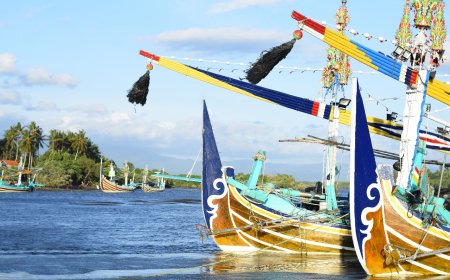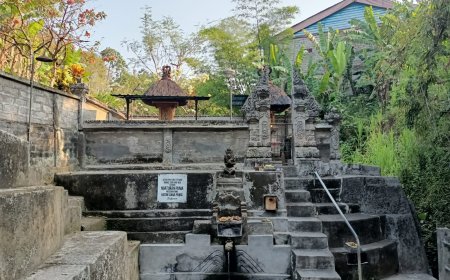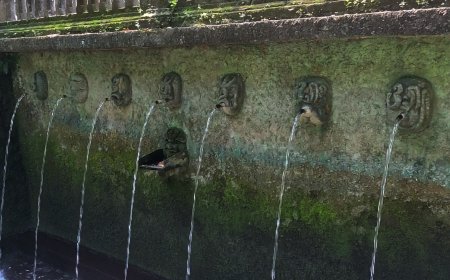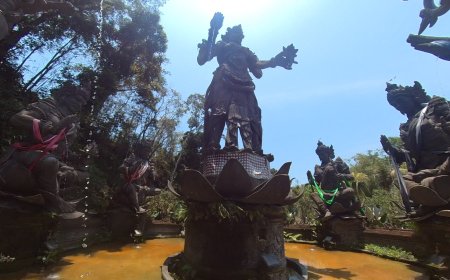A Mystical Exploration of Sapta Gangga Tambawaras: Spiritual and Cultural Enchantment
"Melukat" is a spiritual ritual that is commonly practiced in various religious traditions around the world. In practice, it involves the use of holy water or other materials of spiritual value to cleanse or purify oneself, a place of worship, or the environment of negative energies or spiritual impurities. The process is often accompanied by prayers, mantras or chants that have special spiritual significance and symbolism. The purpose is to spiritually cleanse, celebrate religious values, and unite the community in a common effort towards spiritual purity and togetherness.
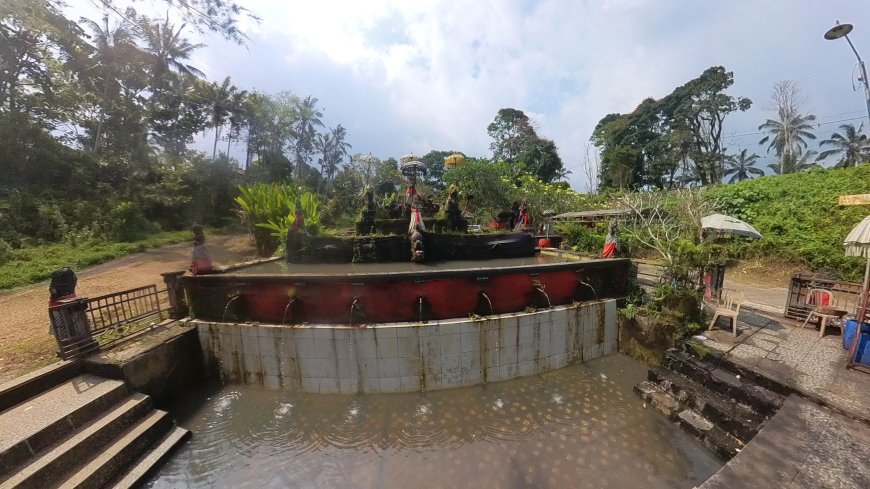
The ritual of consecration is an important part of religious practice that plays a vital role in maintaining spiritual hygiene, purifying sacred places, and uniting the community in a common endeavor towards spiritual sanctity and purification. Involving elements such as holy water, prayers, and special symbolism, it encapsulates important values in religious and cultural beliefs and is an expression of the belief in the importance of sacredness in human life.
Pura Luhur Tamba Waras, as its name implies "medicine for healing," is understood to be derived from the words "Tamba" meaning medicine and "Waras" meaning healing. This makes this sacred place known as a place where medicine is requested for healing. For Hindus, Pura Tamba Waras is a place to do meruwat (cleanse oneself physically and mentally) and ask for healing from illnesses. This temple is also considered a place to ask for medicine that is believed to bring healing. It is important to note that like other temples in Bali, menstruating women are not allowed to perform rituals or prayers here.
 Sapta Gangga Entrance (Photo Source: Personal Collection)
Sapta Gangga Entrance (Photo Source: Personal Collection)
Before starting the prayers at Pura Luhur Tamba Waras, there is a special area called Pancoran Sapta Gangga. Here, there are seven pancoran in a row that have spiritual meaning, known as a place to cleanse themselves both physically and mentally. These seven pancoran include Pancoran Sanjiwani, Kamandalu, Kundalini, Pawitra, Maha Pawitra, Pangurip, and Pasupati. Each pancoran has its own philosophical and symbolic meaning in the purification process, from asking for healing to achieving deeper spiritual understanding. This place becomes an important point before continuing the prayer ritual at the temple. Where the meaning of each pancoran is:
- Sanjiwani: Sanjiwani means holy water that strengthens faith.
- Kamandulu: kamandalu is holy water that serves to purify dirt and words or suksma sarira.
- Kundalini: It is believed that with this attunement, energy can be activated and elevated to higher energy centers, which can result in deep spiritual understanding and awareness.
- Pawitra :Pawitra is an offering or sacred object in Hinduism, used in rituals to purify or cleanse oneself and the environment from negative energies or spiritual impurities.
- Maha Pawitra : Maha Pawitra is an important ritual that involves the use of this sacred object for deeper purification.
- Pangurip: A concept in Javanese life that describes the harmony between man, nature and spirituality. Pangurip reflects harmony and harmony in life.
- Pasupati: One of the manifestations of Lord Shiva in Hinduism that symbolizes universal power and consciousness. Pasupati is associated with the universe and human existence.
For those who have never been to Pura Luhur Tamba Waras, it would be nice to know the procedures for melukat and means of worship first, before doing penglukatan in Pancoran Sapta Gangga, and then praying at the Luhur Temple.
Means of Melukat and Worship
- Prepare the means of worship, at least 2 pieces of pejati and 12 canang sari.
- Prepare bungkak nyuh gading (young coconut), one nyuh gading for each person, also prepare bungkak nyuh gadang (young green coconut) if you want Nunas tamba (please ask for medicine).
The melukat process at Pancoran Sapta Gangga follows a certain order and procedure:
- First, offer pejati (offerings) and perform prayers in the Pancoran Sapta Gangga melukat area before starting the melukat process. Place nyuh gading that has been dikasturi (the top is opened) in the place that has been prepared.
- Next, start the melukat by following the order of Pancoran Sapta Gangga that has been determined.
- After melukat at one of the pancoran, continue by doing nunas tirta (taking holy water) followed by melukat using nyuh gading.
- If you wish to check your physical health spiritually (niskala), seek guidance from the priest at the place and make as many sesari (small offerings) as deemed appropriate.
- The process of melukat at Pancoran Sapta Gangga is complete once the steps have been performed in the prescribed order.
The next steps in the procession are:
- Change wet clothes with traditional clothes that have been prepared to continue praying at Pura Luhur Tamba Waras.
- Next, offer pejati (offerings) at the main temple of Pura Luhur Tamba Waras.
- For those who wish to ask for healing from illness, place a bungkak nyuh gadang that has been dikasturi (the top is opened) with your pejati. If there are many bungkak because of requesting medicine for the group or family, place them in another place with the top open to make it easier for Jro Mangku to fill the medicine.
- Under the direction of Jro Mangku, begin to ask for healing from your illness.
- Afterwards, perform the prayers in accordance with the prescribed procedures.
- When the prayers are over, drink the water from your bungkak nyuh gadang until it runs out in the courtyard outside the temple.
- Thus, the prayer procession at Pura Luhur Tamba Waras has been completed.
The ritual of circumambulation and prayer at Pura Luhur Tamba Waras is a rich manifestation of the spiritual and cultural traditions of the Hindu faith in Bali. The process involves a series of ritualistically structured steps, beginning with the penglukatan at Pancoran Sapta Gangga, which has deep symbolism associated with inner and outer purification. Each pancoran has its own philosophical meaning, reflecting the concepts of purity, spiritual purification and harmony of life. These rituals are not only an expression of religious values, but also an integral part of cultural identity that is carefully guarded by the local community, although some practices may cause controversy, such as access restrictions for menstruating women.
For many visitors, the rituals at Pura Luhur Tamba Waras are not just a series of rituals, but an important moment in the search for spiritual and physical healing. Requests for healing from illness, experiences of clairvoyance with deep symbolism, and prayers offer opportunities for reflection and healing. In addition, within a diverse framework of spirituality and health, alternatives are provided that integrate a holistic approach, openness to religious traditions, and a personal search for the meaning of spirituality. Overall, the ritual presents a unique view of spiritual values, health, and cultural diversity, making for a journey that evokes hope and a profound experience for visitors.









